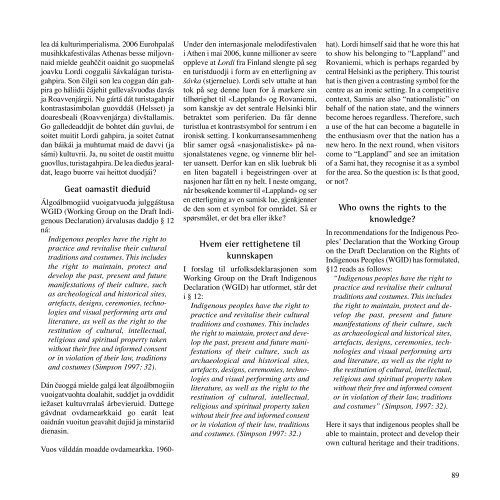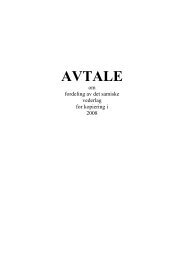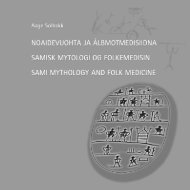Duodji - hvem eier kunnskapen og verkene?
Duodji - hvem eier kunnskapen og verkene?
Duodji - hvem eier kunnskapen og verkene?
You also want an ePaper? Increase the reach of your titles
YUMPU automatically turns print PDFs into web optimized ePapers that Google loves.
lea dá kulturimperialisma. 2006 Eurohpalaš<br />
musihkkafestiválas Athenas besse miljovnnaid<br />
mielde geahččit oaidnit go suopmelaš<br />
joavku Lordi c<strong>og</strong>galii šávkalágan turistagahpira.<br />
Son čilgii son lea c<strong>og</strong>gan dán gahpira<br />
go háliidii čájehit gullevašvuođas davás<br />
ja Roavvenjárgii. Nu gártá dát turistagahpir<br />
kontrastasimbolan guovddáš (Helsset) ja<br />
doaresbeali (Roavvenjárga) divštallamis.<br />
Go galledeaddjit de bohtet dán guvlui, de<br />
soitet muitit Lordi gahpira, ja soitet čatnat<br />
dan báikái ja muhtumat maid de davvi (ja<br />
sámi) kultuvrii. Ja, nu soitet de oastit muittu<br />
guovllus, turistagahpira. De lea dieđus jearaldat,<br />
leago buorre vai heittot duodjái?<br />
Geat oamastit dieđuid<br />
Álgoálbm<strong>og</strong>iid vuoigatvuođa julggáštusa<br />
WGID (Working Group on the Draft Indigenous<br />
Declaration) árvalusas daddjo § 12<br />
ná:<br />
Indigenous peoples have the right to<br />
practice and revitalise their cultural<br />
traditions and costumes. This includes<br />
the right to maintain, protect and<br />
develop the past, present and future<br />
manifestations of their culture, such<br />
as archeol<strong>og</strong>ical and historical sites,<br />
artefacts, designs, ceremonies, technol<strong>og</strong>ies<br />
and visual performing arts and<br />
literature, as well as the right to the<br />
resti tution of cultural, intellectual,<br />
religious and spiritual property taken<br />
without their free and informed consent<br />
or in violation of their law, traditions<br />
and costumes (Simpson 1997: 32).<br />
Dán ču<strong>og</strong>gá mielde galgá leat álgoálbm<strong>og</strong>iin<br />
vuoigatvuohta doalahit, suddjet ja ovddidit<br />
iežaset kultuvrralaš árbevieruid. Dattege<br />
gávdnat ovdamearkkaid go earát leat<br />
oaidnán vuoitun geavahit dujiid ja minstariid<br />
dienasin.<br />
Vuos válddán moadde ovdamearkka. 1960<br />
Under den internasjonale melodifestivalen<br />
i Athen i mai 2006, kunne millioner av seere<br />
oppleve at Lordi fra Finland slengte på seg<br />
en turistduodji i form av en etterligning av<br />
šávka (stjernelue). Lordi selv uttalte at han<br />
tok på seg denne luen for å markere sin<br />
tilhørighet til «Lappland» <strong>og</strong> Rovaniemi,<br />
som kanskje av det sentrale Helsinki blir<br />
betraktet som periferien. Da får denne<br />
turistlua et kontrastsymbol for sentrum i en<br />
ironisk setting. I konkurransesammenheng<br />
blir samer <strong>og</strong>så «nasjonalistiske» på nasjonalstatenes<br />
vegne, <strong>og</strong> vinnerne blir helter<br />
uansett. Derfor kan en slik luebruk bli<br />
en liten bagatell i begeistringen over at<br />
nasjonen har fått en ny helt. I neste omgang,<br />
når besøkende kommer til «Lappland» <strong>og</strong> ser<br />
en etterligning av en samisk lue, gjenkjenner<br />
de den som et symbol for området. Så er<br />
spørsmålet, er det bra eller ikke?<br />
Hvem <strong>eier</strong> rettighetene til<br />
<strong>kunnskapen</strong><br />
I forslag til urfolksdeklarasjonen som<br />
Working Group on the Draft Indigenous<br />
Declaration (WGID) har utformet, står det<br />
i § 12:<br />
Indigenous peoples have the right to<br />
practice and revitalise their cultural<br />
traditions and costumes. This includes<br />
the right to maintain, protect and develop<br />
the past, present and future manifestations<br />
of their culture, such as<br />
archaeol<strong>og</strong>ical and historical sites,<br />
artefacts, designs, ceremonies, technol<strong>og</strong>ies<br />
and visual performing arts and<br />
literature, as well as the right to the<br />
restitution of cultural, intellectual,<br />
religious and spiritual property taken<br />
without their free and informed consent<br />
or in violation of their law, traditions<br />
and costumes. (Simpson 1997: 32.)<br />
hat). Lordi himself said that he wore this hat<br />
to show his belonging to “Lappland” and<br />
Rovaniemi, which is perhaps regarded by<br />
central Helsinki as the periphery. This tourist<br />
hat is then given a contrasting symbol for the<br />
centre as an ironic setting. In a competitive<br />
context, Samis are also “nationalistic” on<br />
behalf of the nation state, and the winners<br />
become heroes regardless. Therefore, such<br />
a use of the hat can become a bagatelle in<br />
the enthusiasm over that the nation has a<br />
new hero. In the next round, when visitors<br />
come to “Lappland” and see an imitation<br />
of a Sami hat, they rec<strong>og</strong>nise it as a symbol<br />
for the area. So the question is: Is that good,<br />
or not?<br />
Who owns the rights to the<br />
knowledge?<br />
In recommendations for the Indigenous Peoples’<br />
Declaration that the Working Group<br />
on the Draft Declaration on the Rights of<br />
Indigenous Peoples (WGID) has formulated,<br />
§12 reads as follows:<br />
“Indigenous peoples have the right to<br />
practice and revitalise their cultural<br />
traditions and costumes. This includes<br />
the right to maintain, protect and develop<br />
the past, present and future<br />
manifestations of their culture, such<br />
as archaeol<strong>og</strong>ical and historical sites,<br />
artefacts, designs, ceremonies, technol<strong>og</strong>ies<br />
and visual performing arts<br />
and literature, as well as the right to<br />
the restitution of cultural, intellectual,<br />
religious and spiritual property taken<br />
without their free and informed consent<br />
or in violation of their law, traditions<br />
and costumes” (Simpson, 1997: 32).<br />
Here it says that indigenous peoples shall be<br />
able to maintain, protect and develop their<br />
own cultural heritage and their traditions.<br />
89




